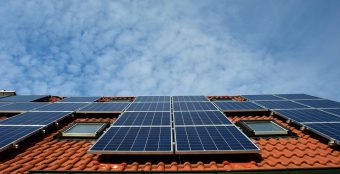
New analysis by GTM Research published a day after Donald Trump applied a 30% tariff on imported solar cells and modules shows that the US solar industry will see a 11% decrease in installations over the next 5 years, a reduction of around 7.6 gigawatts of installed solar between 2018 and 2022.
After 9 months of uncertainty surrounding the fate of the US solar industry, President Donald Trump brought the hammer down on Monday, siding with claimants Suniva and SolarWorld and deciding to award financial relief in the form of 30% tariffs on imported solar cells and modules — reducing 5% each year for the four year duration of the relief, and excluding the first 2.5 GW (gigawatts) of cell imports.
And according to most experts, the effects of the tariff are going to hit the US solar industry hard. According to Abigail Ross Hopper and the Solar Energy Industries Association (SEIA), the move will cost the industry approximately 23,000 jobs this year alone.
A day later, GTM Research has published a new analysis which shows that the newly-instituted tariffs will result in an 11% decrease in US solar PV installations over the next five years (2018-2022), or around 7.6 GW (gigawatts) worth of lost capacity. Deutsche Bank also published figures which mirrored those of GTM Research, expecting module prices to increase by around $0.09/W in the first year, $0.07/W in the second year, $0.05/W in the third year, and $0.03/W in the fourth year.
Specifically, according to GTM, the tariffs will result in an average $0.10/Watt increase in the first year to modules, but decreasing down to $0.04/W by the fourth and final year. For better or worse, GTM expects that the utility-scale segment will fair worse than the residential and commercial solar segments, accounting for around 65% of the expected 7.6 GW reductions.
It is possible that the US solar industry will not lose out dramatically — suffering a weak 2018 before bouncing back — but the overall momentum will have been cut off at the knees, and thousands of people will be out of a job.
“Essentially, this has a meaningful but not destructive impact on solar installations, and at the same time it’s not exceptionally encouraging for domestic solar cell and module manufacturing,” said MJ Shiao, head of Americas research for GTM Research. “Some people look at it as a win-win; some people look at it as a lose-lose.”
One of the saving graces that will hopefully offset some of the negative impacts was a natural inclination among some solar companies to hoard solar cells and modules in the lead up to potential tariffs. Add to this the natural stockpiling which happens as a project is developed.
“The reason why we think the 2018 impacts are muted is because we think there were somewhere between 2 to 3 gigawatts of modules in the US by the end of the year basically dedicated for projects in the works — projects under construction to come online in the first half of the year or allocated modules for projects that will begin construction in early 2018,” said Shiao.
“So that kind of dampers the economic impact. Later this year and in 2019 — when people start to buy more modules fully affected by the tariffs — the full impact sets in.”
However, a new plan by the Rocky Mountain Institute and 35 solar energy industry leaders hopes to offset the impact of the tariffs further by developing an ultra-low-cost solar product that will be a viable alternative in a variety of environments, at fully installed costs of as low as $0.50/W, and a reduction of as much as $0.20/W in 2018 alone. For more on this story, head on over.
All in all, solar manufacturers and industry are disappointed — and there will be immediate and long-term consequences that affect thousands — but it could have been much worse. On the face of it, the International Trade Commission recommended the tariff be 35% — so Trump already went lower than that. He could have gone higher — to match his Oval Office temper tantrum in August, demanding “I want tariffs. Bring me some tariffs.” In the end, it is not impossible to imagine that the evidence and personal pleas actually affected his decision.
Source: cleantechnica.com

